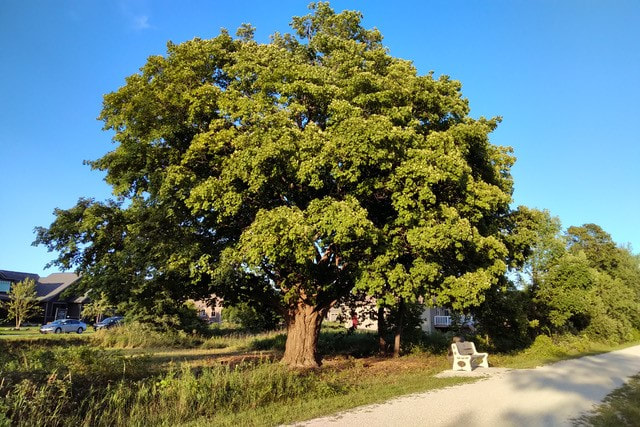|
By Toni Ellis, Elora Environment Centre On a warm, sunny July 2020 morning in the Town of The Blue Mountains just beside the Georgian Trail, Tobias Effinger, owner of Arboreal Tree Care, was suiting up with his team at the base of a majestic 200-year-old Sugar Maple. Several walkers and cyclists stopped in their tracks, expressing alarm at the prospect that this magnificent tree was coming down. No, the crew explained: this tree is being preserved thanks to a new program called Tree Trust. The Elora Environment Centre established Tree Trust in 2019 to help preserve legacy trees by inviting air travellers an opportunity to donate to help make up for their carbon footprint in their own community. Donations are used to hire skilled arborists to practice conservation arboriculture techniques that extend the lives of significant local legacy trees. In the case of the Thornbury Sugar Maple, Arboreal Tree Care work included retrenching the upper canopy, removing deadwood, reducing the co-dominant stem and adding compost to the rooting area. The success of Tree Trust has inspired other communities to replicate the program – including the Toronto Island Community, Stratford Perth and the Town of The Blue Mountains. Ironically, just as expansion began, the pandemic hit and air travel diminished significantly. As a result, the program has pivoted to appeal to donors who simply want to see big trees in their community preserved rather then left to a slow (and occasionally quick) decline. While few people fly these days, they are spending an unprecedented amount of time outdoors and are learning to appreciate the grandeur of older, large trees. Many people, including our Prime Minister, cite the value of tree planting as a tool to combat climate change, however it is not just new trees that are needed. Most people are surprised to learn that while newly planted saplings work to get established, the big trees do the heavy lifting, sequestering tonnes of carbon and providing a of myriad environmental benefits. A study done out of Ohio University cites that: "All tree benefits can be assigned a monetary value. For example, a northern hackberry tree with a 36-inch diameter growing in a single-family residential area has an overall economic benefit of approximately $370 per year. If this hackberry tree were to be removed, it would take 269 two-inch diameter trees to provide the same carbon sequestration benefits for one year, and all prior years of carbon sequestration benefits would be lost." In short, mature trees are a tool in the fight against climate change.
Mature trees also provide habitats for countless species. According to a Land for Wildlife Queensland publication, “by virtue of their size, old trees provide more food and nesting resources than younger trees. For example, one 300-year-old Grey Box (Eucalyptus macrocarpa) with a height of 20 metres and a trunk diameter of 1.5 metres has a bark surface area of approximately 94 m2 while a 20-year-old tree with a trunk diameter of 20 cm and a height of 15 metres has a bark surface area of just 9 m2. An animal can therefore forage as profitably on one large tree as on ten smaller trees, at the same time decreasing the risk of predation by not having to travel from one tree to the next.” Not only do we care for mature trees, but for every legacy tree in the Tree Trust program we plant at least two young trees nearby to one day take over. Tree Trust is a good news story offering the public a way to contribute to preserving important legacy trees. It also serves as a ramp for local communities to take on more tree action. Town of The Blue Mountains, for example, after enjoying such a successful inaugural season, plans to establish a local, native tree seedling nursery as its next community-funded effort. Interested in bringing Tree Trust to your community, or simply want to learn more? Visit treetrust.ca. And as for that Georgian Trail Sugar Maple, Arborist Tobias Effinger ensures us that this glorious tree has the potential to continue its good work for decades to come.
1 Comment
8/24/2023 12:33:49 am
Tree climbers may apply treatments or pesticides to address pest infestations or diseases affecting trees.
Reply
Leave a Reply. |
AuthorWrite something about yourself. No need to be fancy, just an overview. Archives
July 2024
Categories |



 RSS Feed
RSS Feed
